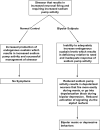Role of endogenous ouabain in the etiology of bipolar disorder
- PMID: 33523310
- PMCID: PMC7851255
- DOI: 10.1186/s40345-020-00213-1
Role of endogenous ouabain in the etiology of bipolar disorder
Abstract
Background: Bipolar disorder is a severe psychiatric illness with poor prognosis and problematic and suboptimal treatments. Understanding the pathoetiologic mechanisms may improve treatment and outcomes.
Discussion: Dysregulation of cationic homeostasis is the most reproducible aspect of bipolar pathophysiology. Correction of ionic balance is the universal mechanism of action of all mood stabilizing medications. Recent discoveries of the role of endogenous sodium pump modulators (which include 'endogenous ouabain') in regulation of sodium and potassium distribution, inflammation, and activation of key cellular second messenger systems that are important in cell survival, and the demonstration that these stress-responsive chemicals may be dysregulated in bipolar patients, suggest that these compounds may be candidates for the coupling of environmental stressors and illness onset. Specifically, individuals with bipolar disorder appear to be unable to upregulate endogenous ouabain under conditions that require it, and therefore may experience a relative deficiency of this important regulatory hormone. In the absence of elevated endogenous ouabain, neurons are unable to maintain their normal resting potential, become relatively depolarized, and are then susceptible to inappropriate activation. Furthermore, sodium pump activity appears to be necessary to prevent inflammatory signals within the central nervous system. Nearly all available data currently support this model, but additional studies are required to solidify the role of this system.
Conclusion: Endogenous ouabain dysregulation appears to be a reasonable candidate for understanding the pathophysiology of bipolar disorder.
Keywords: Bipolar disorder; Calcium; Endogenous ouabain; Ouabain; Pathophysiology; Sodium; Sodium pump.
Conflict of interest statement
Dr. El-Mallakh is on the speakers’ bureau of Alkermes, Indivior, Intra-Cellular Therapeutics, Janssen, Lundbeck, Otsuka, Sunovion, and Teva. The other authors do not have any conflicts of interests to declare.
Figures
Similar articles
-
Endogenous Cardiac Steroids in Bipolar Disorder: State of the Art.Int J Mol Sci. 2022 Feb 6;23(3):1846. doi: 10.3390/ijms23031846. Int J Mol Sci. 2022. PMID: 35163766 Free PMC article. Review.
-
Sleep deprivation is associated with increased circulating levels of endogenous ouabain: Potential role in bipolar disorder.Psychiatry Res. 2022 Mar;309:114399. doi: 10.1016/j.psychres.2022.114399. Epub 2022 Jan 17. Psychiatry Res. 2022. PMID: 35078006
-
Possible role of endogenous ouabain-like compounds in the pathophysiology of bipolar illness.Med Hypotheses. 1993 Oct;41(4):378-83. doi: 10.1016/0306-9877(93)90089-9. Med Hypotheses. 1993. PMID: 8289709
-
Response of sodium pump to ouabain challenge in human glioblastoma cells in culture.World J Biol Psychiatry. 2009;10(4 Pt 3):884-92. doi: 10.1080/15622970902995620. World J Biol Psychiatry. 2009. PMID: 19995221
-
Endogenous ouabain, sodium balance and blood pressure: a review and a hypothesis.J Hypertens. 1996 Feb;14(2):151-67. doi: 10.1097/00004872-199602000-00002. J Hypertens. 1996. PMID: 8728291 Review.
Cited by
-
Endogenous Cardiac Steroids in Bipolar Disorder: State of the Art.Int J Mol Sci. 2022 Feb 6;23(3):1846. doi: 10.3390/ijms23031846. Int J Mol Sci. 2022. PMID: 35163766 Free PMC article. Review.
-
Involvement of the Na+, K+-ATPase α1 Isoform and Endogenous Cardiac Steroids in Depression- and Manic-like Behaviors.Int J Mol Sci. 2024 Jan 29;25(3):1644. doi: 10.3390/ijms25031644. Int J Mol Sci. 2024. PMID: 38338921 Free PMC article.
-
NMDA receptor inhibition prevents intracellular sodium elevations in human olfactory neuroepithelial precursors derived from bipolar patients.Sci Rep. 2022 Jun 21;12(1):10437. doi: 10.1038/s41598-022-14187-w. Sci Rep. 2022. PMID: 35729322 Free PMC article.
-
Differentially Altered Metabolic Pathways in the Amygdala of Subjects with Schizophrenia, Bipolar Disorder and Major Depressive Disorder.medRxiv [Preprint]. 2024 Apr 19:2024.04.17.24305854. doi: 10.1101/2024.04.17.24305854. medRxiv. 2024. Update in: Schizophr Bull. 2024 Nov 11:sbae193. doi: 10.1093/schbul/sbae193. PMID: 38699334 Free PMC article. Updated. Preprint.
References
-
- Antolovic R, Bauer N, Mohadjerani M, Kost H, Neu H, Kirch U, Grünbaum EG, Schoner W. Endogenous ouabain and its binding globulin: effects of physical exercise and study on the globulin's tissue distribution. Hypertens Res. 2000;23(Suppl):S93–S98. doi: 10.1291/hypres.23.Supplement_S93. - DOI - PubMed
Publication types
LinkOut - more resources
Full Text Sources
Other Literature Sources


